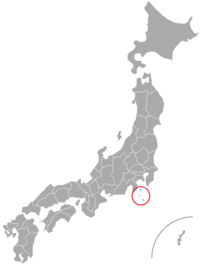Northern Izu Archipelago dialects
| Northern Izu Archipelago dialects | |
|---|---|
| 北部伊豆諸島方言 | |
 Northern Izu Islands within Japan. | |
| Native to | Japan |
| Region | Izu Islands, Tokyo |
| Dialects |
|
| Language codes | |
| ISO 639-3 | – |
The Northern Izu Archipelago (or Islands) dialects (Japanese: 北部伊豆諸島方言 hokubu izu shoto hogen) are
common standard
.
General features
The following are general phonetic and grammatical features of the Northern Izu Archipelago dialects, with exceptions and individual variations listed in the island-specific sections.
Phonology
The Northern Izu Archipelago dialects have a chūrin (中輪 ‘middle rim’) Tokyo standard pitch accent. The vowel sound /e/ is somewhat narrower than in traditional Tokyo dialects, and may lose its distinction with /i/ to become [i].[1][2] For example:
- eki (駅 train station) → iki
- kebyō (仮病 feigning illness)→ kibyō
- fude (筆 writing brush) fudi
- tenki (天気 weather)→ tinki
- sensei (先生 teacher) → shinshē [2]
In some dialects, there is a /tu/ syllable. For example:
- tsurizao (釣り竿 fishing rod) → tuizao [2]
Grammar
Northern Izu Archipelago dialects are classified under
Eastern Japanese, with similar grammar structures to Shizuoka and West Kantō dialects
, but also with a strong influence from the traditional Yokohama dialect. As aforementioned, however, the differences from island to island can be extreme. Below are some notable grammatical traits.
- The conclusive auxiliary verb is the characteristic Eastern Japanese -da (だ).
- The connective form of u-ending Godan verbs experience small tsu (っ) insertion, whilst su-ending Godan verbs experience i-euphony. (The North Izu dialects are the furthest east this trait is found)
- Bē (べ) (or bei (べい) on To-shima) is used for persuasion and volition. -U (-う) is also used for volition.
- For reasons, -kara (から) and -node (ので) are generally used, with exceptions on To-shima and Mikura-jima (listed below).
Izu Ōshima
- On Izu Ōshima, pitch accent is based on the chūrin Tokyo standard but is not identical, rather a slight variation.
- The negative verb form is [-nai stem + nai (-ない)].
- For conjecture, zura (ずら) is used.
- The plain form of verbs appears as -n (-ん). For example) kuru (来る to come)→ kun (来ん), suru (する to do)→ shin (しん), neru (寝る to sleep)→ nen (寝ん).
Nii-jima
- In the older generation of Nii-jima, /e/ is lengthened.[1]
- In the Nii-jima Honmura dialect, the phonemes /ti/ and /di/ are also observed.
Mikura-jima
- The negative verb form is [-nai stem + nee (ねぇ)].
- For conjecture, danbē (だんべぇ) and darō (だろう) are used.
Miyake-jima
- In Tsubota, /e/ tends to change to an [i], with a particularly strong tendency to do so on the syllables ke (け) and re (れ).[1][3]
- The negative verb form is [-nai stem + nee (ねぇ) ].
- For conjecture, zura (ずら) and darō (だろう) are used.
- -nke (-んけ) is used as an equivalent to kara and node.
To-shima
- The vowels in /ce/ and /co/ are pronounced close to an i and u, respectively.[4]
- The diphthong /ei/ is not merged and is pronounced [ei], so that sensei (先生 teacher) is not sensē but sensei.[5]
- The negative verb form [nai-stem + n (ん) ] is used.
- For conjecture, dan’nō (だんのう) and darubei (だるべい) are used.
- -ni (-に) is used as an equivalent to kara and node.
- A distinction between the attributive and plain form of verbs can be seen. The attributive form ends with -o, whilst the plain form ends with a -u when particles like bei and na (な) are attached. For assertions, the verb ends with -o.[6] For example:
- iru (いる to be)→ iro (いろ)
- neru (寝る to sleep)→ nero (寝ろ)
- suru (する to do)→ shiro (しろ)
- shite iru (している is doing)→ shitero (してろ)
- kaku (書く to write)→ kako (書こ).
- The Western Japanese past negative form -zatta (-ざった was not) is found.
References
- ^ a b c 飯豊, 毅一 (1984). 講座方言学 5 関東地方の方言 (in Japanese). 国書刊行会. p. 242.
- ^ a b c Hirayama, Teruo (1965). 伊豆諸島方言の研究 (in Japanese). Meiji. pp. 87–89.
- ^ Hirayama, Teruo (1965). 伊豆諸島方言の研究 (in Japanese). Meiji. pp. 153–155.
- ^ 柴田, 武 (1988). 方言論 (in Japanese). 平凡社. pp. 284–285.
- ^ 飯豊, 毅一 (1984). 講座方言学 5 関東地方の方言 (in Japanese). 国書刊行会. p. 244.
- ^ 飯豊, 毅一 (1984). 講座方言学 5 関東地方の方言 (in Japanese). 国書刊行会. pp. 261–268.
